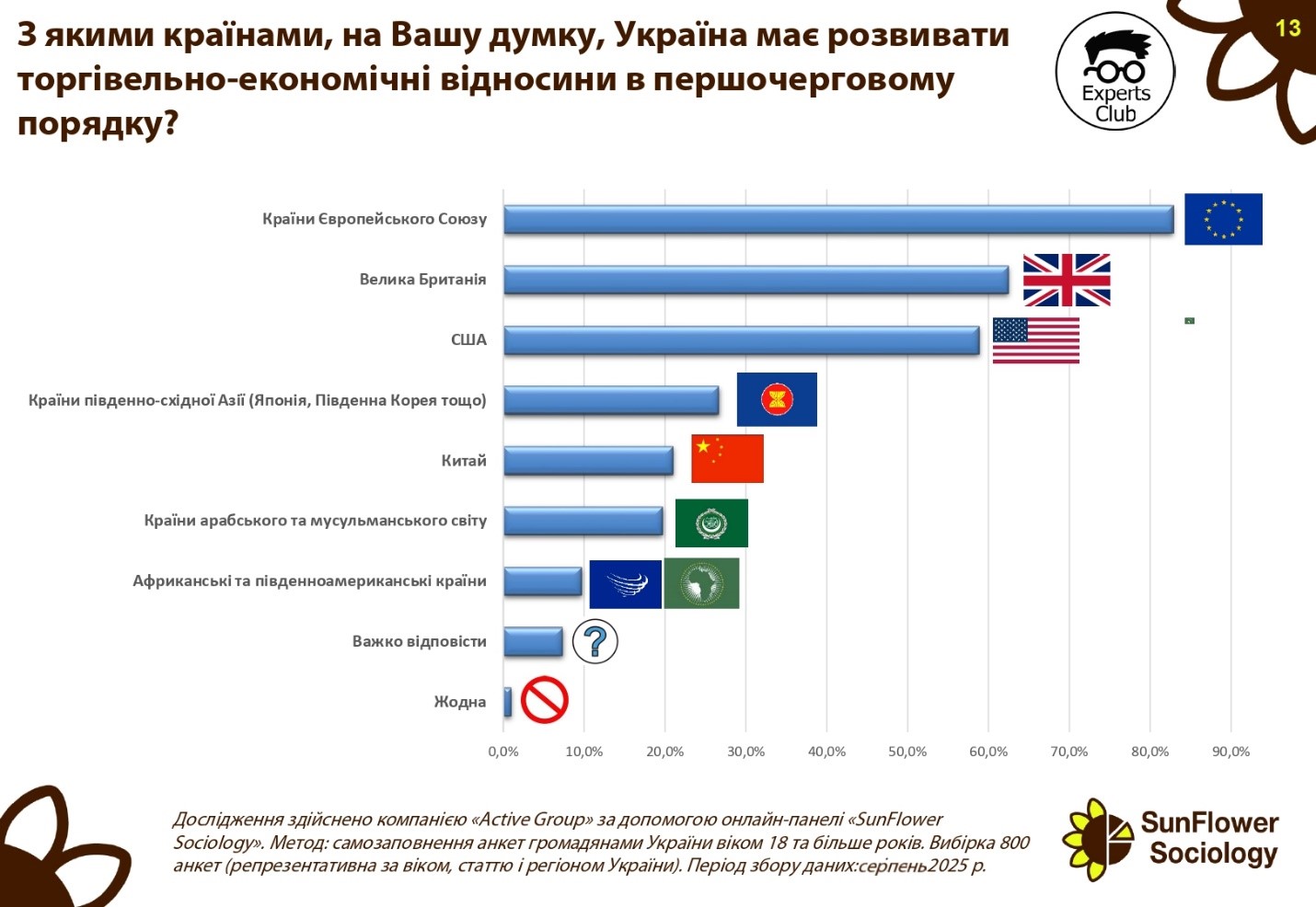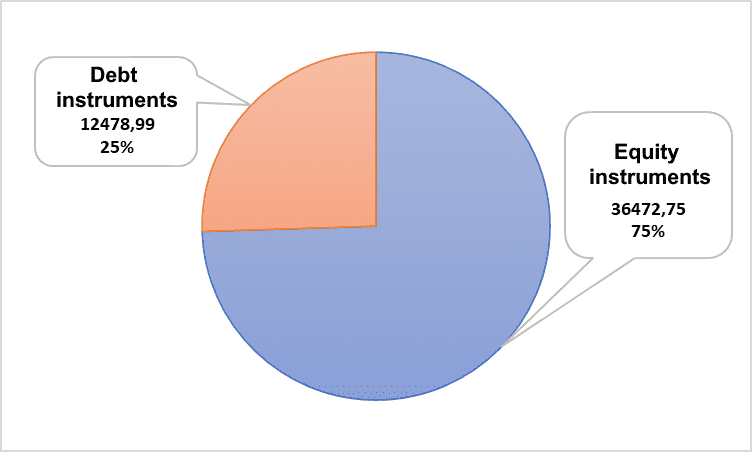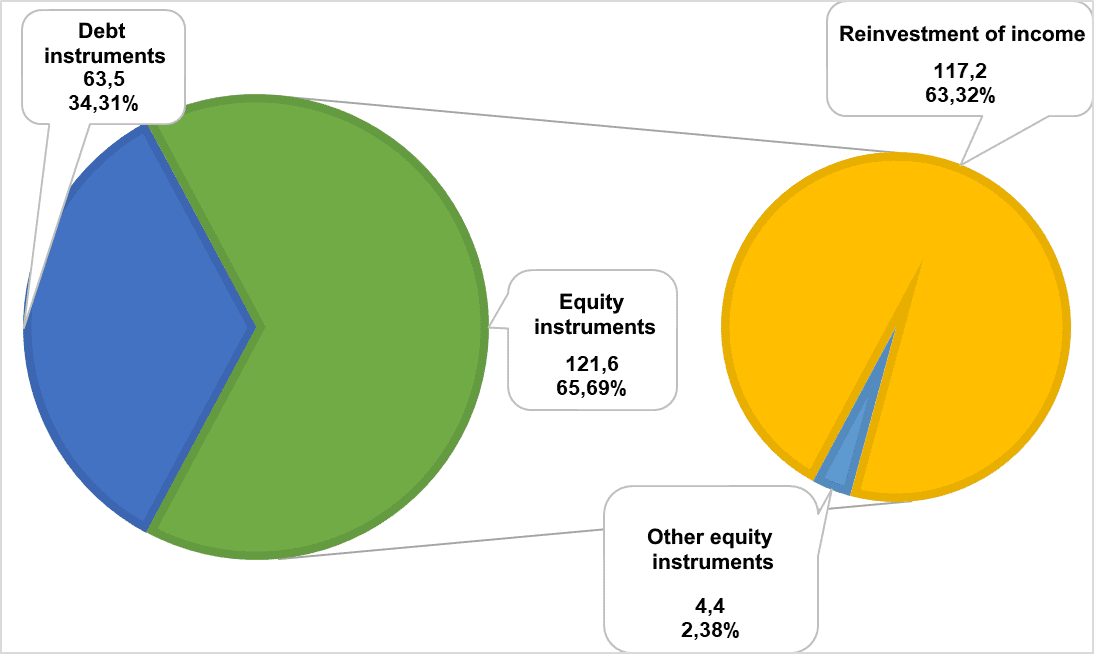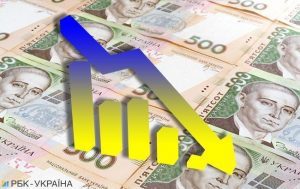
According to the results of a survey conducted by Active Group in collaboration with Experts Club in August 2025, Ukrainians identified priority areas for the development of foreign economic relations.
The majority of respondents – 81.3% – believe that Ukraine should first and foremost develop economic cooperation with the countries of the European Union. The United Kingdom also received a high level of support – 66.5%, while the United States came in third with 62.7%.
Citizens also pay significant attention to Asian countries: 36.2% of respondents support expanding relations with Southeast Asian countries (Japan, South Korea, etc.), and 31.7% with China. At the same time, 29.5% pointed to the importance of deepening cooperation with countries in the Arab and Muslim world.

To a lesser extent, respondents are focused on partnerships with African and South American countries — this direction was supported by 14.8% of Ukrainians. Another 8.3% of respondents were undecided, and 1.0% believe that Ukraine does not need any new economic partnerships.
“These data clearly demonstrate the European and transatlantic orientation of Ukrainians in terms of economic priorities. The EU, the UK, and the US form the basis of foreign economic trust, while Asia and the Arab world are perceived as promising but secondary partners,” commented Active Group Director Oleksandr Pozniy.
According to Experts Club co-founder Maksim Urakin, the survey results confirm the real economic structure of Ukraine’s trade.
“The EU is already Ukraine’s main trading partner, accounting for over 40% of trade turnover, but if we analyze individual countries, China remains the leader. The high levels of support for cooperation with the UK and the US reflect society’s trust in Ukraine’s political and economic partners during this difficult period. At the same time, interest in Asia and the Arab world indicates the need to diversify markets and seek new opportunities in the future,” he stressed.
The survey was conducted using self-completed questionnaires among 800 Ukrainian citizens aged 18 and older. The sample is representative in terms of age, gender, and region.
ACTIVE GROUP, Arab countries, CHINA, EU, EXPERTS CLUB, GREAT BRITAIN, JAPAN, Pozniy, SOCIOLOGY, SOUTH KOREA, TRADE, UKRAINIAN ECONOMY, URAKIN, USA

The status of a candidate member of the European Union will give impetus to a new trajectory of Ukraine’s GDP growth and a positive signal to investors, Andriy Hunder, President of the American Chamber of Commerce in Ukraine (ACC), believes.
“The EU candidate status will kick-start a new GDP growth trajectory, while at the same time providing huge morale for post-war economic transformation and reform implementation. Such a move sends a positive signal to investors that Ukraine is moving in the right direction,” he said in a comment to the agency. Interfax-Ukraine.
“There is no future for transparent business in Russia. At the same time, companies will see Ukraine as a priority for post-war investment,” Gunder said.
He also expressed confidence that with a positive decision on such a status by the EU members, Ukraine will make every effort to implement all the necessary reforms as soon as possible. In particular, to introduce real and effective judicial reform, the rule of law, fair justice and the establishment of a level playing field for business.
“We will see a comprehensive approach to creating a strong state and a competitive economy,” Andrei Gunder stressed.
“The message on the status of Ukraine’s candidate for membership in the European Union is clear – Ukraine is returning home. Ukraine is returning to the European family of peoples, the values it shares, and, once and for all, is moving away from the yoke of Russia’s cruel suffocation,” he said.
Acceleration of Ukraine’s membership in the European Union by approximating national legislation in the field of competition, customs, healthcare, protection of intellectual property rights, media, etc. to EU legislation is one of the key priorities for member companies of the American Chamber of Commerce in Ukraine for the post-war economic recovery of Ukraine, added the ACC President.
FOREIGN DIRECT INVESTMENT IN THE ECONOMY OF UKRAINE AS OF 09/30/2020 (BALANCE, $ MILLION)

FOREIGN DIRECT INVESTMENTS IN THE ECONOMY OF UKRAINE IN 2020 (OPERATIONS, $ MILLION)


Oxford Economics has improved its forecast for Ukraine’s GDP fall in 2020 to 4.6% compared to 4.9% of GDP in the November forecast, according to the December forecast.
The fall of the Ukrainian economy in 2020 may amount to 5.5% of GDP with a further recovery of growth by 3.5-4% in the next two years, analysts at Deutsche Bank expect.
The Kyiv School of Economics (KSE) expects the economy to fall by 5.1% of GDP in 2020, according to the KSE economic activity review for the fourth quarter of this year.
The National Bank of Ukraine (NBU) preliminarily estimates the loss of Ukraine’s GDP from the enhanced quarantine in January 2021 at 0.2%, Deputy NBU Governor Dmytro Sologub has said.
The fall in the gross domestic product (GDP) of Ukraine in July-September 2020 amounted to 3.5% compared to the same period in 2019, the State Statistics Service confirmed its preliminary assessment, published in mid-November.
The deficit of Ukraine’s foreign trade in goods in January-October 2020 decreased by 71.4% compared to January-October 2019, to $3.354 billion from $8.496 billion, the State Statistics Service reported on Tuesday.
The growth of consumer prices in Ukraine in November 2020 accelerated to 1.3% from 1% in October and 0.5% in September after falling by 0.2% in August and 0.6% in July, reported the State Statistics Service on Wednesday.
The 2021 national budget provides for a deficit of 5.5% of GDP, or UAH 246.6 billion, according to the text of the law released on the website of the Finance Ministry on Monday.
Most members of the Monetary Policy Committee of the National Bank of Ukraine (NBU) expect the key policy rate to rise to 6.5-7.5% in 2021 due to the predicted rise in inflationary pressures, the regulator’s website said on Monday.
The total public debt of Ukraine in November 2020 increased by 1.16% in U.S. dollars, to $ 84.24 billion and by 1.27% in hryvnias, to UAH 2.398 trillion, according to data on the website of the Ministry of Finance.
The prices of industrial producers in Ukraine in November 2020 increased by 2%, while in October by 3.8%, in September by 1.7%, in August by 2.3%, in July by 0.4%, and in June and May their decline was recorded by 2% and 0.6%, respectively, the State Statistics Service has said.
Industrial production in Ukraine in November 2020 compared to November 2019 decreased by 0.3%, while in October by 5%, in September by 4.4%, in August 5.3%, in July 4.2%, June 5.6%, May 12.2% and April 16.2%, the State Statistics Service has reported.
Since the beginning of the new 2020/2021 marketing year (MY, July-June) and as of December 11, Ukraine has exported 22.89 million tonnes of grains and legumes, which is 3.8 million tonnes less than year-over-year.
The transport companies of Ukraine in January-November 2020 reduced transportation of goods by 11.6% compared to the same period in 2019, to 546.6 million tonnes, the State Statistics Service has reported.
Ukrainian transport companies carried 2.345 billion passengers in January-November 2020, which is 39.9% less than in the same period in 2019, the State Statistics Service has reported.
Retail trade turnover in Ukraine in November 2020 increased by 12.1% compared to the same month in 2019 in comparable prices, while in the previous month the growth was 15.2%, the State Statistics Service has said.

The fall of the Ukrainian economy in 2020 may amount to 5.5% of GDP with a further recovery of growth by 3.5-4% in the next two years, analysts at Deutsche Bank expect.
According to the materials of Emerging Markets Outlook 2021, experts admit that the next tranche of the International Monetary Fund (IMF) will be allocated to Ukraine in early 2021, which will pave the way for obtaining funding from other international partners.
At the same time, the central bank will leave the discount rate at 6% per annum, according to the review.